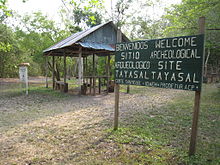Tayasal
Tayasal , on Mayathan or Itzá Noh Petén ("city island") or Tah Itzá ("place of Itzá") was a Mayan city-state of the Itzá ethnicity, located in the north of today's Guatemala . It was the last independent Mayan state until 1697. The Spaniards built the city of Flores on its ruins .
location
Tah Itzá was located on an island in Lake Petén Itzá in what is now the Guatemalan Department of Peten . Because of this location, the city was easy to defend.
history
After the destruction of Chichén Itzá , the Itzá moved south to Lake Petén-Itzá, where they founded their new capital, Tayasal, on an island in 1194.
Hernán Cortés came in 1523 on his march to Honduras in pursuit of Cristóbal de Olid , shortly after he had hanged the Aztec king Cuauhtémoc near Xicalango, with an army of Spaniards and about 600 Chontal Mayas through Tayasal. He met the Itzá ruler ( halach winik ) , Ah Kaan Ek ("black snake", Hispanic Canek), and held a Catholic mass with him . The Spaniards left a dying horse. Fearing that the Spanish would blame the Itzá for the death of the horse, they built a wooden horse to replace it.
After the conquest of Guatemala and the Yucatán , the Spaniards tried repeatedly to take Tah Itzá. An attack under Hernán Cortés in 1541 was repulsed by the Itzá warriors.
In 1618 two Jesuit priests , accompanied by several hundred indigenous people from Belize, visited the city of Tah Itzá and were initially received in a friendly manner. When the priests saw that the Itzá worshiped the wooden horse Tzimin Chac ("Horse of Thunder"), which was built in the time of Cortés, they destroyed it and a dispute ensued. The ruler ( Ahau ) of the Itzá, Ah Kaan Ek, had the Spaniards expelled.
There were several unsuccessful attempts at military conquest by the Spaniards, for example in 1685 from Belize, 1687 from Alta Verapaz and 1691 and 1695 from Yucatán. The governor of Yucatán Martín de Ursúa y Arizmendi eventually assembled a Spanish army from units from Tabasco and Yucatán. On March 13, 1697, it stormed the last free Mayan city. Combat ships were also used, which were brought in from the coast and assembled on the shores of Lake Petén Itzá.
Trivia
The historical novel Die Mayapriesterin ( Heyne , Allgemeine Reihe , ISBN 3-453-21225-8 ) describes the events from the point of view of the two mentioned Jesuit priests.
Individual evidence
- ↑ Diego López de Cogolludo "Conquista de Yucatán" Cap.XVI Foundation for the advancement of mesoamerican studies inc
literature
- Antonio Mediz Bolio (2005): Libro de Chilam Balam de Chumayel , Traducción del maya al español. México, ed.Dante ISBN 970-605-277-1
- Diego López de Cogolludo (1688): Historia de Yucatán (2006) Madrid, ed.Linkgua. ISBN 84-9816-640-3
Web links
- Ralph L. Rays (1933): The Book of Chilam Balam of Chuyamel . Washington DC, Carnegie Institution (PDF file; 3.03 MB)
- Diego de Landa: Relación de las Cosas de Yucatán (PDF file; 501 kB)

